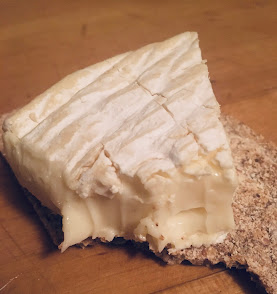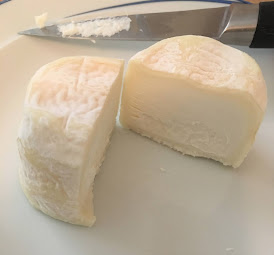 |
Dirt Lover cheese in its cute wrapper.
|
Dirt Lover sheep's milk cheese is a curious little nugget of tastiness. I found it difficult to review this product immediately after having sampled Kinderhook Mini. I kept comparing the two instead of simply enjoying what was on my plate. Both are made from sheep's milk, and both have a bloomy rind. That said, compared to Kinderhook Mini, Dirt Lover is drier and sharper with a more pronounced tang. It's also a tiny bit saltier, but not in a bad way.
I was trying to find the word to describe the cute little shape of this cheese. In more popular terms, it's known as a cylinder, but I kept thinking there was another word like crottin or crotte that described the extra petite barrel. Crottin is actually a different cheese, similar in shape to Chabicou and le Chevrot. All of these cheeses have a similar form that's small, round, and not too tall. When I learned that crotte is French for poop, usually of the horse or farm animal variety, I couldn't help but laugh. I'm not going to show images, but, regarding shape only, sometimes the little nuggets of cheese sort of do look like something you might accidentally step in at the barn. Try not to think of manure when sampling this cheese because, when it comes to taste, they have nothing in common.
 |
The little nugget of cheese is intriguing.
|
There's so much to love about the birthplace of this cheese, Green Dirt Farm, founded by Sarah Hoffmann, a woman who wanted to raise her children on a farm where they could enjoy spending time outdoors in the fresh air. But Sarah wasn't moving to the country in Missouri just for herself and her family. She had an idea to create an environmentally sustainable sheep dairy where the animals would be treated humanely. From there, it took a few years before she was ready to begin selling cheese. She had to learn the cheese-making process and then think about the production end of the business first, but after six years, everything fell into place. Once the cheeses landed on the market, it's no surprise that Green Dirt Farm products started winning a variety of awards. These days, Sara and her daughter, Eliza, work with a small team to keep the business running smoothly and ethically.
From the Green Dirt website:
As the ewes munch on this rich smorgasbord of grasses throughout
the seasons, the flavors in the milk changes, and so do the flavors in
the cheeses. We celebrate these unique flavors as they reflect what the
sheep are eating in the moment and remind us of the seasonality of life
on the farm.
In addition, the milk of grass-fed ruminants naturally contains more
omega-3 fatty acids, conjugated linoleic acid, beta-carotene, and
vitamins E & A. This enriched nutritional profile means our
grass-fed sheep’s milk products are both healthier and more flavorful.
But you don’t have to take our word for it, we are proud to be Animal Welfare Approved.
This means that we raise our animals humanely, outdoors on pasture,
allowing them to behave naturally and socialize freely. We are audited
yearly to ensure that we are maintaining Animal Welfare Approved’s
strict standards.
Similar to Selles Sur Cher but not as dark, Dirt Lover is coated with ash. Selles Sur Cher is coated with wood ash whereas Dirt Lover is covered in a light coating of vegetable ash. Vegetable ash is exactly what it sounds like, vegetable matter that has been dried and charred until it's turned into ash. Ash doesn't typically have much flavor and is sometimes added simply for show, but it is also used in cheese making for several functional reasons. Folklore claims that a light dusting of ash on the evening curd kept the flies from sampling the goodies when folks were making cheese, and then more curd was simply added on top of the ash the next day. These days, increased production is such that most cheeses are made from one milking, and the reality is that ash was probably added because it keeps the curds from spoiling by soaking up excess moisture without adding much flavor. Whether of the wood or vegetable variety, ash is mostly carbon, and it neutralizes the acidic surface of developing cheeses. A lower PH encourages the right kind of mold, specifically penicillium candidum and geotrichum in bloomy rinds, to develop while keeping unwanted mold, especially blue, black, green, or red, from forming.
With added ash on its surface, Dirt Lover more easily forms a thin rind as the 100-percent pasteurized sheep's milk cheese ripens for about two weeks. As with other "live rind" cheeses, fats and proteins break down over time and create a gooey texture just inside the rind of Dirt Lover, but the majority of the cheese is a wonderful firm texture. In the same way that wines can be dry and wet at the same time, so is this fromage. The dryness is no mistake, and don't worry because the finish is creamy on the palate. The paste itself isn't as creamy as most Brie-like cheeses, but the overall mouthfeel is smooth. It's the kind of cheese that makes you smack your lips with a great flavor that's balanced nicely.
 |
The Dirt Lover interior is white.
|
Despite a lack of any strong mushroom smell, Dirt Lover has a lovely earthy flavor that's rich, nutty, and buttery. The obvious tang from the sheep's milk isn't overwhelming or overly sour and makes this more interesting than other more traditional bloomy rind cheeses. In the early stages of aging, this little appetizing button has hints of citrus as the paste lingers on your tongue. In the later stages, notes of hay and the barnyard stand out. I can see why the cheesemonger who sold me this little gem was excited about it.
It was hard for me to pair this cheese with anything. I wanted to just keep eating it plain and savor the wonderful complexities of this intriguing dairy product, however, it does go exceptionally well with crusty French bread, which is no surprise since it's modeled after some of the old European cheeses that made the use of ash in cheese making popular. It looks and tastes great in salads, on cheese boards, and with fruit platters. Although it takes away from the attractive look of the cheese, it can also be used in cooked dishes or baked in a crust like Brie.
As far as wines, you can be daring and try this with a Sangiovese blend that will draw out the complexities of this cheese. It's also great with rose, Merlot, an unoaked Chardonnay, Sancerre, Chenin Blanc, Prosecco, and even tawny port. If it's beer you're into, go with a pale ale, wheat beer, or an IPA.






















